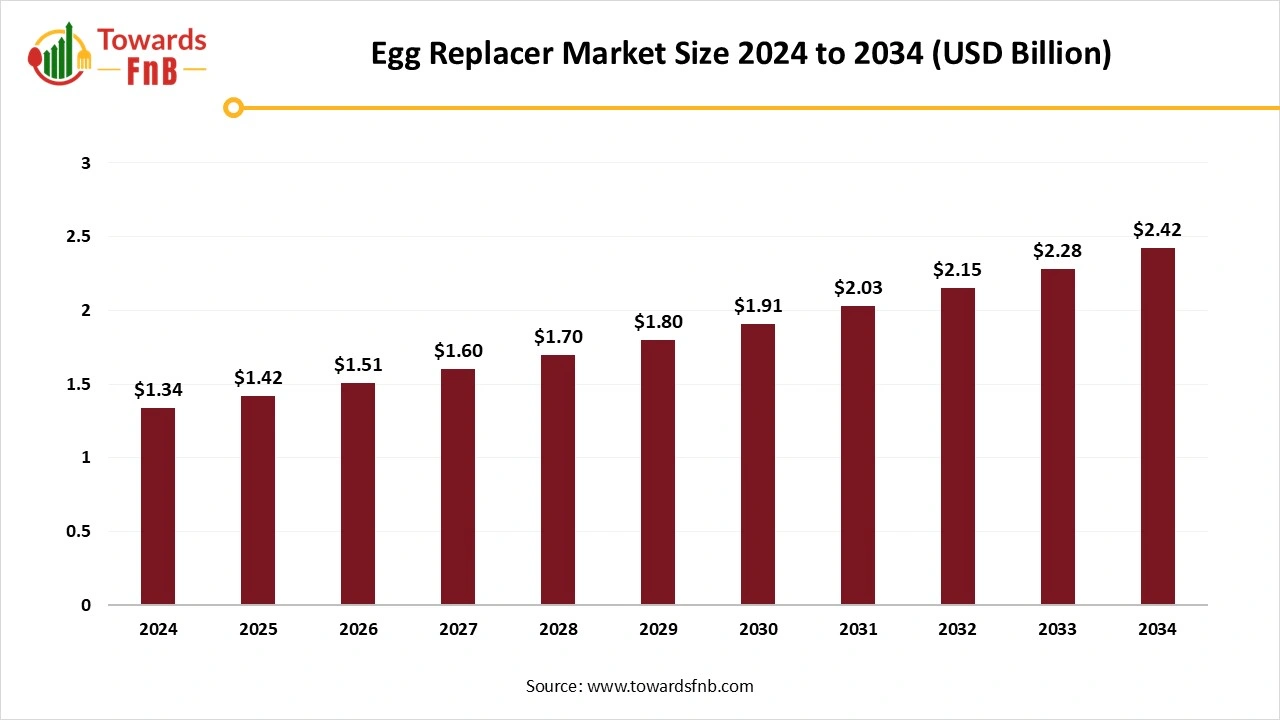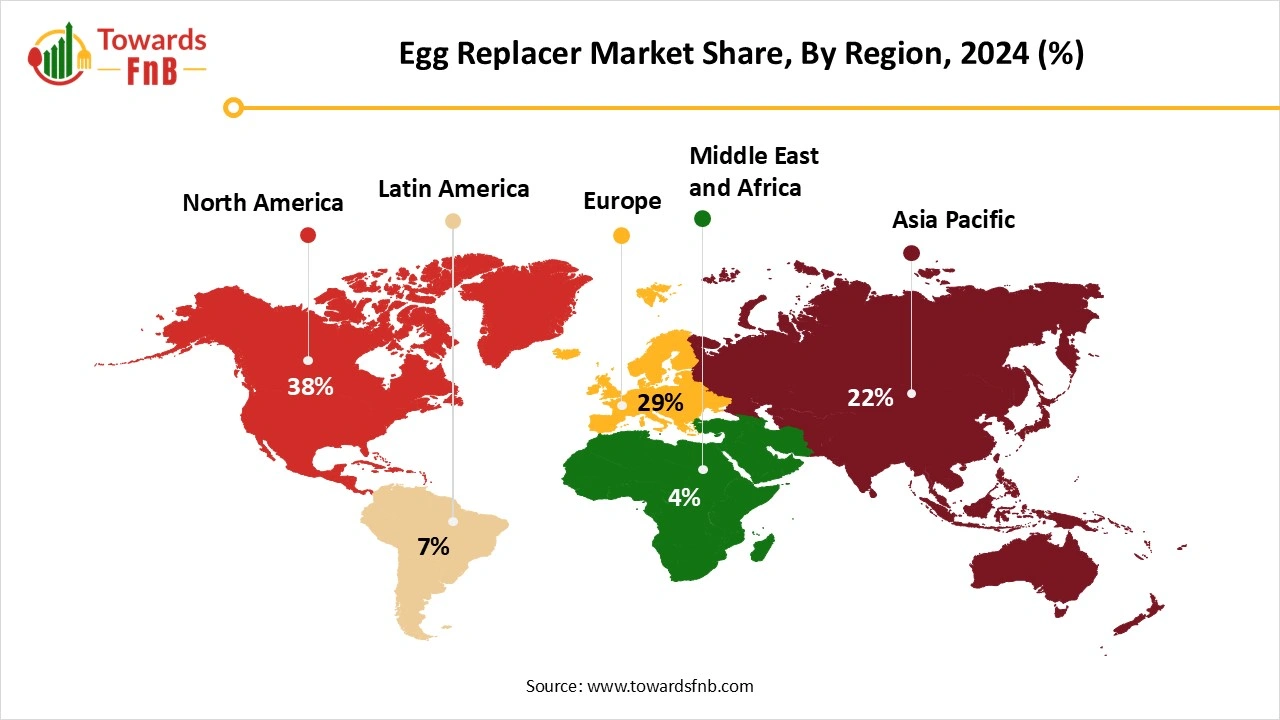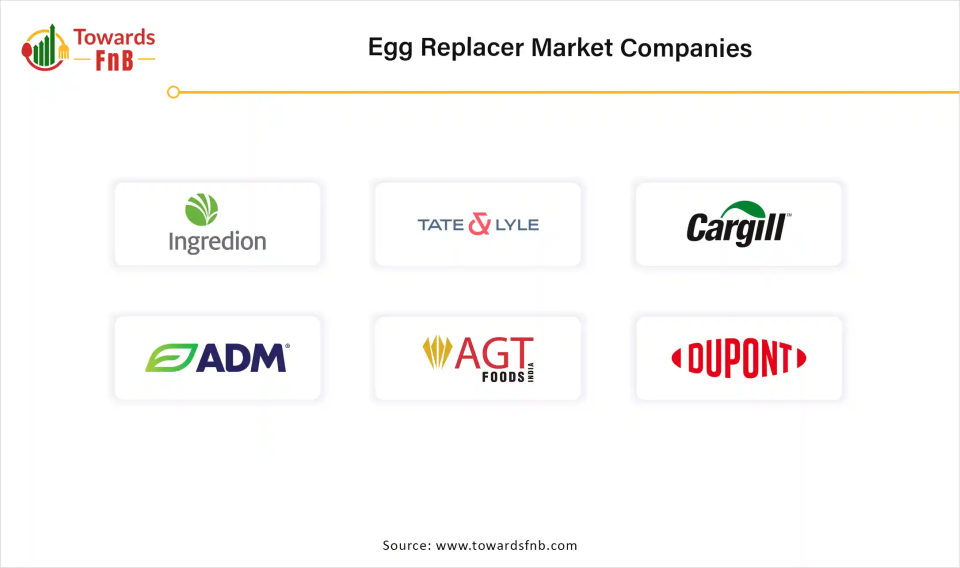November 2025
The global egg replacer market size reached at USD 1.34 billion in 2024 and is anticipated to increase from USD 1.42 billion in 2025 to an estimated USD 2.42 billion by 2034, witnessing a CAGR of 6.1% during the forecast period from 2025 to 2034. Growing demand for the plant-based and allergen-free diet due to rising veganism and vegetarianism significantly expanding the market.

| Study Coverage | Details |
| Growth Rate from 2025 to 2034 | CAGR of 6.1% |
| Market Size in 2025 | USD 1.42 Billion |
| Market Size in 2026 | USD 1.51 Billion |
| Market Size by 2034 | USD 2.42 Billion |
| Largest Market | North America |
| Base Year | 2024 |
| Forecast Period | 2025 to 2034 |
| Regions Covered | North America, Europe, Asia-Pacific, Latin America, and Middle East & Africa |
The egg replacer market refers to the global market for plant-based or synthetic ingredients used to replace eggs in various food and beverage applications. These ingredients are primarily used to mimic the functional properties of eggs, such as binding, leavening, emulsifying, and providing moisture in baking and other food preparation. Egg replacers are most used by individuals who follow vegan diets, have allergies to eggs, or seek to reduce cholesterol intake. The growing awareness of plant-based diets, increasing demand for vegan and allergen-free products, and advancements in food technology have driven the growth of this market.
The potential exists in broadening the use of egg replacer. At present, they are mainly utilized in baking, yet there is an opportunity to investigate their application in various food categories such as savory meals, sauces, and confections. This would necessitate additional research and development to produce egg substitutes with unique functional properties suited for various cooking uses. Additionally, focusing on consumer groups with customized marketing and educational efforts creates another opportunity. By meeting their unique needs and worries, businesses can successfully connect with new customer groups and promote market growth.
A significant issue in the egg replacer market is their functional constraint in fully substituting eggs. The egg offers various functions in food uses, including binding, emulsifying, leavening, and enhancing texture. Although some of these roles can be substituted with egg alternatives, achieving identical performance in all culinary applications presents a technical difficulty. This would naturally lead to continuous research and development initiatives aimed at enhancing their adaptability and efficiency, allowing the egg alternatives to replace eggs in numerous food products as much as possible without compromising product quality or customer satisfaction
North America Egg Replacer Market Trends
North America dominated the egg replacer market in 2024. The North America market is an important part of the region's food sector, fueled by rising consumer interest in plant-based and allergen-free food options. Egg substitutes act as functional elements that replicate the characteristics of eggs in different cooking uses, such as baking, candy making, and savory dishes. With a growing trend towards veganism, vegetarianism, and allergy-aware diets, the demand for egg substitutes is consistently increasing. North America, which includes the United States, Canada, and Mexico, experiences strong growth in this market, driven by advancements in food technology, increasing health awareness, and sustainability efforts.
Nonetheless, obstacles like formulation intricacies, regulatory factors, and consumer acceptance of alternative products affect market dynamics. The most popular imitation eggs are created from starches, plant proteins, soy ingredients, and various plant sources. Regarding sales, the North American market accounts for nearly half of the worldwide imitation egg industry (47.8%) and is projected to lead until 2026. At the end of 2021, profits in this area were estimated at US$476.6 million, representing 32% of the sales.

United States Egg Replacer Market Trends
The increasing consumer shift towards plant-based diets is a major factor influencing the U.S. Egg Replacer Market Industry. A study by the Plant Based Foods Association shows that 39% of U.S. consumers are adding more plant-based foods to their meals. A rise in health awareness among consumers in the US greatly enhances the U.S. Egg Replacer Market Industry. The Centers for Disease Control and Prevention emphasizes that roughly 70% of adults in the United States are working to enhance their diets and lower their cholesterol consumption. The demand for egg substitute products is increasing as more producers and distributors build stronger partnerships. Producers are working to expand their product offerings by sourcing new natural ingredients or substitutes for eggs, while also enhancing the taste and texture of their items to mimic the flavor of eggs.
Asia Pacific expects the significant growth during the forecast period. The expansion of the Asia Pacific egg replacer market is fueled by various compelling elements. Growing health awareness among consumers and the rising incidence of egg allergies are greatly driving the need for substitutes. The increasing number of vegans and vegetarians, particularly in nations such as India, China, and Australia, is driving the growth of plant-based food, including substitutes for eggs. Moreover, innovations in food technology have allowed producers to develop egg replacements that closely resemble the flavor, texture, and usability of actual eggs, enhancing their attractiveness to both consumers and food manufacturers. Concerns about the environment and ethics related to animal farming are prompting consumers to opt for plant-based alternatives.
Japan Egg Replacer Market Trends
The demand in the Japan egg replacer market has been rising, mainly due to the increasing consumer interest in plant-based and allergen-free options. Producers are continuously working to enhance the flavor, mouthfeel, and nutritional quality of egg alternatives to align more closely with consumer demands. A recent piece by Japan News highlights the growing popularity of egg alternatives in the nation, attributing it mainly to the escalating prices of chicken eggs. Moreover, the rise of clean-label items and the incorporation of alternative proteins have played a crucial role in the increasing acceptance of these substitutes. The advanced retail and foodservice sectors in Japan have promoted the extensive availability of these products. Japan's biggest egg product manufacturer, "Kewpie," introduced HOBOTAMA in 2020, garnering significant attention. It appears to have originated from reactions to egg allergies and is anticipated to expand alongside plant-based eggs and vegan alternatives as plant-based foods gain broader acceptance
Which Product Type Dominated the Egg Replacer Market in 2024?
Starch-based egg replacers segment led the egg replacer market in 2024, due to the creation of modified starches designed to replicate egg characteristics. These encompass emulsifying, binding, and moisture retention abilities. Additionally, starches are significantly cheaper than other egg substitute ingredients; therefore, they are highly attractive to any producer aiming to reduce production costs while maintaining quality. Possessing an unflavored taste ensures they do not change the flavor profile of the product, providing a significant benefit in preserving the intended taste of different foods. Innovations like enzymatically processed starches and pregelatinized starch have surfaced as effective substitutes, providing texture and functionality akin to eggs. For example, blends made from pea starch are becoming popular due to their clean-label and allergen-free qualities.
Protein-Based Egg Replacers Segment is Observed to Grow at the Fastest Rate During the Forecast Period.
Growing consumer demand for plant-based options and the emergence of veganism and flexitarian diets have led to the creation of plant-based egg replacers to cater to vegans, people with egg allergies, and those looking for healthier or more sustainable choices. These options seek to mimic the cooking flexibility and health advantages of conventional eggs while tackling ecological issues. Mung bean extract, found in items such as Just Egg, has plant albumins and globulins that resemble egg proteins. Lupin beans serve as an additional protein source used in products like Simply Eggless.
Which Application Segment Held the Dominating Share of the Egg Replacer Market in 2024?
Baking segment held the dominating share of the egg replacer market in 2024. Eggs serve an essential function in baking, functioning as binders, leavening agents, and emulsifiers. Egg substitutes are designed to mimic these properties, enabling the production of cakes, cookies, pastries, and various baked items with comparable textures, binding, and moisture content to those made with eggs. Consumers are progressively looking for plant-based and allergen-free options in their food, such as baked goods. This change in consumer tastes has increased the need for egg substitutes, particularly within the baking industry. The meat alternatives sector is expected to expand significantly over the anticipated period.
Meat Alternatives Segment is Seen to Grow at a Notable Rate During the Predicted Timeframe.
Diets that cut back on or remove animal products are becoming more popular, which is anticipated to drive market growth. Moreover, the worry over the rise of animal-transmitted diseases has amplified health apprehensions, resulting in a decrease in the consumption of animal products. With increasing awareness of meat alternatives, an increasing number of consumers are embracing these options, acknowledging their possible health advantages, such as helping to prevent non-communicable diseases, digestive problems, and obesity. An increasing number of consumers are raising doubts about egg consumption and the impact of our diets on animals, the environment, and our health. This is also evident in the growing demand for alternatives without eggs.
Why did the Plant-Based Segment Dominate the Egg Replacer Market in 2024?
Plant-based segment dominated the market with the largest share in 2024. Plant-based eggs typically contain less saturated fat and are cholesterol-free, attracting those who wish to cut down on animal product intake. These options are made without antibiotics or hormones, reflecting the rising consumer interest in health-oriented products. The safety considerations surrounding plant-based eggs, particularly regarding foodborne illness issues, have resulted in an increased acceptance of these alternatives.
Animal-Free Segment is Expected to Grow at the Fastest Rate in the Egg Replacer Market During the Forecast Period.
The increasing popularity of veganism and the expansion of the flexitarian diet are also boosting the market for animal-free egg replacer. With an increasing number of consumers embracing these diets, the need for animal-free egg substitutes is anticipated to keep rising. For example, the Oggs product utilizes aquafaba, which is the liquid from chickpeas.
Which End User Segment Held the Largest Share of the Egg Replacer Market in 2024?
Food manufacturers segment held the largest share of the market in 2024. Egg substitutes are components utilized in place of eggs when making a range of food items. Egg is a prevalent allergen and can lead to minor rashes or severe allergic responses. The yogurt, arrowroot powder, applesauce, and different ingredients serve as an egg replacement in commercial use. Egg prices are unpredictable because of their short shelf-life and varying demand associated with the seasonal use of egg-based food items. Leading firms manufacturing egg substitutes are concentrating on innovating products to meet the increasing demand from consumers. The rising consumer desire for vegan processed food items has boosted the demand for products like vegan egg alternatives. Consumer adaptation of low-cholesterol egg alternatives like banana, tofu, yogurt, and more will propel the egg replacer market in the coming years.
Home Consumers Segment is Observed to Grow at the Fastest Rate During the Forecast Period.
The rising demand for vegan baking and enriched food items has increased the requirement for functional egg alternatives in domestic kitchens. Even individuals who are not strictly vegan are cutting back on their meat and egg intake, resulting in an increased demand for egg replacers in home cooking. Egg replacers are increasingly accessible in stores and online, simplifying the process for consumers to include them in their diets.
Which Form of Egg Replacer Dominated the Egg Replacer Market in 2024?
Powdered form segment led the market in 2024. Powdered egg substitutes have become prevalent due to their enhanced shelf-life, convenience in transportation, and adaptability in various food uses like baked goods, dressings, and ready-to-consume meals. Powdered egg substitutes provide dependable performance regarding moisture retention, emulsification, and binding, making them appropriate for various food items. Powdered substitutes for eggs are commonly utilized in baking, sweets, sauces, and various convenience food, providing a flexible option for food producers.
Liquid Form Segment is Seen to Grow at a Notable Rate During the Predicted Timeframe.
The need for liquid egg substitutes is growing because they are ideal for uses that need fast hydration and improved mixing, like sauces, dressings, and ready-to-drink products. Liquid forms also serve foodservice and industrial customers who emphasize convenience and quicker preparation periods. Even though the liquid segment currently occupies a smaller market share than powders, its expansion is driven by advancements in clean-label, refrigerated plant-based liquid blends that attract both commercial kitchens and retail consumers looking for fresher, minimally processed options.
Which Distribution Channel Dominated the Egg Replacer Market in 2024?
Offline sales segment held the dominating share of the market in 2024. This can be largely credited to the prevalence of product placement in physical grocery stores rather than in the online store. The market is uniquely specialized and developing, with most participants involved in retailing through grocery stores, supermarkets, and hypermarkets. In stores, items are frequently positioned near traditional products to enhance consumer interest and broaden target exposure.
Online Sales Segment is Expected to Grow at the Fastest Rate in the Market During the Forecast Period.
As online shopping becomes more popular, consumers are discovering it simpler to buy egg replacers, thus expanding the market's reach. Websites provide a diverse range of egg substitutes, featuring multiple brands and varieties, frequently accompanied by comprehensive product details and user feedback. Shoppers can conveniently compare prices, read reviews, and shop from home, saving both time and effort.
How did the Binding Agent Dominated the Functionality Segment in the Egg Replacer Market in 2024?
Binding agent segment dominated the market with the largest share in 2024. Egg replacers excel as binders while improving texture and taste. Numerous egg substitutes, particularly those made from starch such as potato and tapioca starch, can efficiently perform this binding role. They solidify and form gels, offering the essential structure and texture to various foods. Starch-based and dairy protein alternatives are adaptable, being utilized in various food products such as bakery goods, sauces, and dressings.
Leavening Agent Segment is Observed to Grow at the Fastest Rate During the Forecast Period.
Attributed to technological advancements, growing demand for convenient and plant-based foods, and an increase in veganism and dietary limitations. For instance, combining 1 tsp (7 g) of baking soda with 1 tbsp (15 g) of vinegar can substitute for 1 egg in many recipes. Combining vinegar and baking soda initiates a chemical reaction that generates carbon dioxide and water, resulting in light and airy baked goods.
Corbion
Crespel & Deiters Food USA
Neggst

By Product Type
By Application
By Source
By End-User
By Form
By Distribution Channel
By Functionality
By Region
November 2025
November 2025
November 2025
November 2025